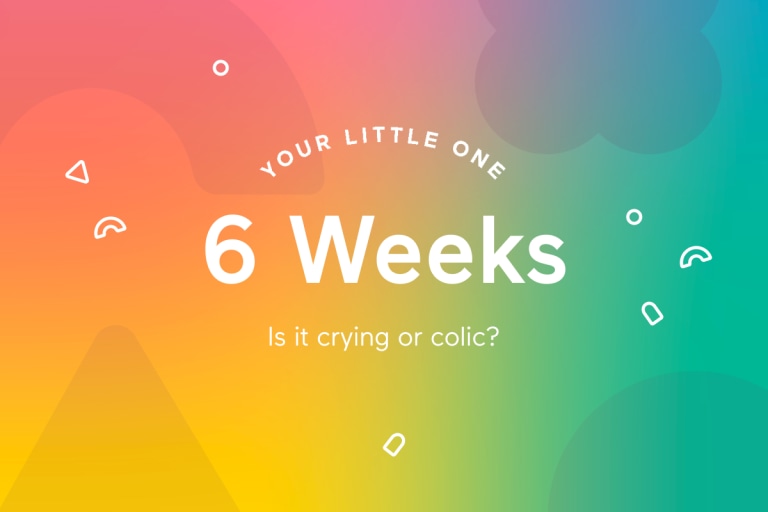
Your 6-Week-Old Baby
Milestones (for both of you!), massage and the lowdown on colic.

By Babylist Staff
Doctor’s Corner: The Lowdown on Colic
Every baby cries—it’s how they communicate. But when those sobs are frequent, prolonged and excessive, it could be colic.
Colic is defined as crying for 3-plus hours a day, 3-plus days a week, for 3-plus weeks. It usually starts when your baby is around two weeks old, peaks around six weeks, and starts to decline by three or four months of age.
There isn’t a specific cause behind colic, which makes it tricky to manage. Some docs speculate it’s due to a still-developing digestive system with muscles that may spasm, gas or an oversensitivity to light and noise.
Talk to your pediatrician for tips on how to lessen the severity of colic. There’s no one-size-fits all solution, but soothing goes a long way. Try a pacifier, swaddling, warm baths, car rides, walking and rocking, and gentle tummy massages to help release gas. During bottle feedings, be sure to keep your baby in an upright position and burp often. Many bottles are designed with special anti-colic features that help reduce air intake to minimize stomach discomfort.
Parenting a baby with colic can be exhausting and emotional (it’s hard to hear all that crying and not swoop in with a quick fix!). Take breaks, ask for help and don’t be hard on yourself if you need to put your baby in the crib and go in another room to take some deep breaths. Just know that colic will go away and be one of those things you tease your kid about when they’re a teenager.
Your 6-Week OB Appointment
The past month-and-a-half have probably felt like a whirlwind. So it’s hard to believe it’s time to see your doc for a postpartum checkup. Whether you had a c-section or vaginal delivery, your OB will check you out to assess how you’re healing and hopefully give you the greenlight to resume activities like light exercise and sex. Talk about birth control options and ask any and all questions (nothing is off limits!). Be sure to fill your doctor in on any pain or discomfort you may be having.
And don’t put your mental wellbeing on the backburner. While feeling emotional is super common as a new mom, if you’re experiencing intense anxiety or depression, it’s important to seek help from a professional ASAP.
6-Week-Old Milestone
Between birth and three months, your baby will start reacting to loud sounds with a startle reflex or cry. The upside: they’re soothed by soft sounds, especially your voice. The downside: they’re more easily awakened by dog barks, deliveries and doorbells (try turning on the white noise machine during naptime).
How to Take Baby’s Temperature
It’s important to call your doctor if a baby under three months old gets a fever (100.4 F and up). If your child is younger than three years, a rectal temperature gives the best reading. Here’s how to do it (there’s more in-depth information on taking baby’s temperature here):
- Clean the end of the thermometer with rubbing alcohol or soap and water. Rinse it with cool (not hot!) water.
- Put a small amount of petroleum jelly (or similar lubricant) on the end.
- Place your child belly down across your lap or on a firm surface. Hold them by placing your palm against their lower back, just above their bottom. Or lay your child face up and bend legs to the chest. Rest your free hand against the back of the thighs.
- With the other hand, turn the thermometer on and insert it 1/2 inch to 1 inch. Hold it in place loosely with 2 fingers, keeping your hand cupped around your child’s bottom. Keep it there for about 1 minute, until you hear the beep (which we know can feel like forever!). Then remove and check the reading.
Infant Massage
Take your bedtime routine up a notch by adding in a baby massage. The perfect post-bath ritual, it sets the scene for good ZZZs and is an extra sweet way to bond with your little one. According to the Mayo Clinic, infant massage has plenty of great health benefits—it helps your baby relax and sleep, positively affects infant hormones that control stress and can even reduce crying.
Use baby oil or lotion and gently rub your kiddo’s hands, arms, shoulders, legs, feet, belly, neck, and upper back. Talk to your baby and sing soft songs. You can also extend and flex your baby’s arms and legs for soothing stretches. Try to avoid a massage right after a feeding or when your baby is extra fussy.
Baby’s Sleep at 6 Weeks Old
At around six weeks, your little one may start sleeping for shorter stretches during the day and longer stretches at night (but multiple night wakings will still most likely be the norm!). Experts say this is a good time to start creating good sleep habits.
Also know that even as your baby is awake for longer stretches at a time, they still need lots of sleep. Most babies give pretty clear signs of getting tired, from rubbing eyes to yawning to not being as engaged as they are when they’re rested. Keeping an eye out for these can help you know it’s time to put them down for a nap again before they melt down.